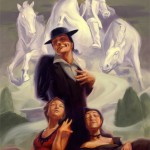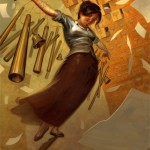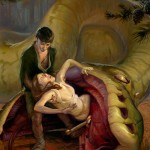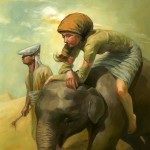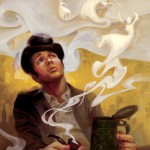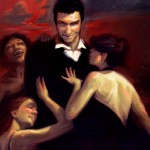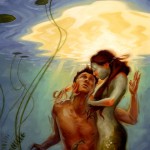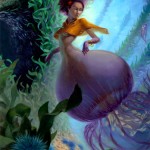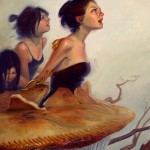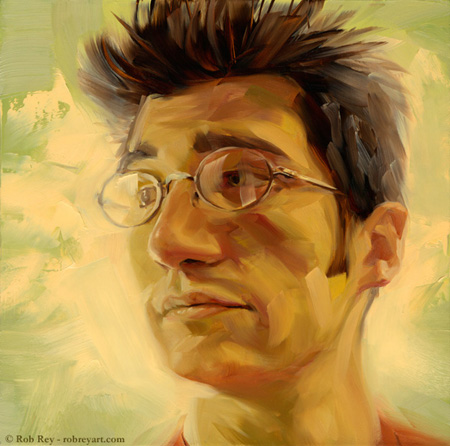 L’ospite di Vis-à-vis oggi è Rob Rey, 25 anni, artista e illustratore americano.
L’ospite di Vis-à-vis oggi è Rob Rey, 25 anni, artista e illustratore americano.
1. Qual è stata la tua formazione e come ti sei avvicinato all’arte in generale e al genere che pratichi in particolare?
Al liceo pensavo di voler diventare un ingegnere perché ero bravo in matematica e scienze. Quando realizzai che c’era un motivo per cui avevo seguito tutti corsi d’arte che il mio liceo offriva, decisi di andare ad una scuola d’arte. Pensavo di voler fare il graphic designer ma quando andai alla Rhode Island School of Design scoprii il campo dell’illustrazione e, da quel momento, è stato un amore appassionato. Una volta immerso nell’illustrazione, ho capito, immediatamente, che la pittura ad olio era la mia vocazione e mi focalizzai, quasi esclusivamente, su quella tecnica per tutti i miei lavori scolastici. Al RISD incontrai Jon Foster, durante il mio ultimo anno lì e lui fu così gentile da farmi dipingere per un periodo sotto la sua guida. Questo mi aiutò molto, mi laureai nel 2006 con una gran voglia di imparare di più. Da allora, poi, ho studiato costantemente su libri di pittura e attraverso il disegno e la pittura dal vivo.
2. Quali sono le tue fonti di ispirazione?
Tutto, ovunque…dovunque io la possa trovare. I musei sono davvero ottimi per trovare l’ispirazione. Anche osservare le persone è il mio passatempo preferito. Disegnare un nudo va bene, ma, in realtà, io trovo che la varietà delle persone e l’individualità della loro personalità visuale siano eccitanti. Io disegno, regolarmente, alla caffetteria locale.
3. Quali sensazioni vuoi comunicare attraverso le tue opere?
Ultimamente trovo che i temi agrodolci siano, per me, irresistibili e questa è la direzione verso cui lavoro. Essi vengono in molte forme ed emozioni ma la comunicazione di quest’ultime è la chiave ed il punto centrale per me.
4. Descrivi il tuo lavoro.
Ho cominciato con schizzi in miniatura, poi ho lavorato su disegni più grandi e ho finito con l’olio su tavola. Diluisco con l’olio di semi di lino solo se voglio ottenere un effetto smaltato, ma in molti casi uso il colore così come viene fuori dal tubetto e cerco di applicarlo usando solo le pennellate necessarie.
5. Quanto tempo impieghi per progettare e realizzare un’opera?
A seconda di come mi sento, ho la necessità di esplorare ogni possibile opzione per fare la scelta migliore. Come ho già detto, un’opera è il risultato finale di una lunga serie di scelte fatte dall’artista. Trovo che due settimane siano, comunque, il giusto tempo per realizzare un’opera, una settimana per lo schizzo e una per la pittura finale.
6. Nelle tue illustrazioni l’atmosfera è favolosa…quali emozioni vuoi trasmettere all’osservatore?
Grazie. Come ho detto prima, l’emozione è la chiave. Ciò che voglio trasmettere è l’emozione che io sento, sperando che colpisca e sia compresa dallo spettatore il più possibile. Molte volte sono emozioni di desiderio, brama, perdita. A volte sono in contrasto con l’oggetto, serenità con rabbia, ecc…
7. Ritieni che sia dato sufficiente spazio agli artisti nei canali istituzionali? Come ritieni che si possano superare i limiti dall’arte ufficiale?
Due domande interessanti. Mentre il mondo intero sta correndo cercando di fare soldi, e tutto per comprare il pane o una Lexus, è difficile persuadere la gente comune a fermarsi e guardare qualche altra cosa. Non è questo l’obiettivo di un artista? Persuadere la gente a fermarsi, prestare attenzione e, magari, provare qualcosa. Spero che ci sia più appoggio per l’arte nei canali istituzionali, ma non dico che dovrebbero sostenere l’arte perché mi piace. La gente dovrebbe sentire la necessità di sostenere l’arte perché gli piace. Per farsi piacere qualcosa, l’osservatore ha bisogno di capirla; penso ci sia un tempo per andare oltre i limiti dell’arte ufficiale, ma per la maggior parte, penso siano i limiti che rendano comprensibile l’arte al pubblico e a fare il suo successo. Siamo una società consumista che si muove velocemente e la gente ha bisogno di una vasta proposta di prodotti per poter, poi, scegliere quello che più le piace sullo scaffale. Questo può suonare frivolo, ma anche con i limiti ci sono infinite possibilità. L’unica cosa che si può dare allo spettatore è qualcosa a cui aggrapparsi, qualcosa con cui cominciare. In questo modo, forse, è il pittore tradizionale che parla, ma credo che dovremmo proclamare i nostri limiti così come proclamiamo il loro superamento. Poi, forse, troveremo il supporto che cerchiamo nei canali istituzionali senza imporci su di essi.
8. Quali sono i tuoi prossimi progetti?
Sto lavorando ad alcune illustrazioni per un “librogame” e ad alcuni quadri figurativi.
Original Version
1. What training do you come from and how did you approach art, the genres you practice in particular?
In High School I thought I would be an engineer, but only because I was good at math and science. When I realized that there was a reason I had taken every art class that my high school offered I decided to go to art school. At that time I thought I would be a graphic designer, but when I got to the Rhode Island School of Design I discovered the field of illustration and it’s been a passionate love affair ever since.
Once immersed in illustration, I knew almost as immediately that oil painting was my calling and focused on the medium almost exclusively for all my assignments in school. While at RISD I met Jon Foster, and during my last year as a student there and he was kind enough to let me paint under him for time. This was very helpful and I graduated in 2006 with a hunger to learn more. Since then I’ve been in constant study with painting books, life drawing, and life painting.
2. What are your sources of inspiration?
Everything, everywhere… where ever I can get it. Museums are especially good for inspiration. People watching is a major pastime for me too. Drawing a nude model is fine, but I really find the variety of every day people and the individuality of their visual personalities to be endlessly exciting. I draw regularly at my local coffee shop.
3. What kind of sensations do you want to communicate through your works?
Ultimately, I find themes of the bittersweet to be the most compelling to me and this is what I work towards. This comes in many forms and emotions, but communication of emotion is key and is a central focus of mine.
4. Describe your work and the techniques you use.
I start with thumbnail sketches, work up to a larger drawing, and then finish with oil on board. I work with a generous amount of short (not thinned) paint. I’ll thin the paint with linseed oil if I want to glaze, but in most cases just use it as it comes out of the tube and try to apply it with only as many strokes as are necessary.
5. How long does it take you to conceive and realize a work?
As has been said, a painting is the end result of a long string of choices made by the artist. I’m working towards finding the best choices faster and I find two weeks to be a comfortable amount of time, with one week for sketch and one week for final painting.
6. In your illustrations, the atmosphere is fabulous…what emotions you want to transmit to your observer?
Well, thank you. As I said before, emotion is key. The emotion I want to transmit is the emotion that I feel will affect and resonate with the view as much as possible. Many times these are emotions of loss, desire, longing. Sometimes an emotion that is in contrast to subject matter, peacefulness with ugliness, anger with beauty, etc.
7. Do you think artists are given sufficient space in institutional channels? How do you think limitations of official art could be overcome?
An interesting pair of questions. While the whole world is running around try to make a buck, whether it’s to buy bread or to buy a Lexus, it’s hard to get the everyday person to stop and look at anything. Really that’s the major goal of the artist, isn’t it? To get people to stop, pay attention, and then perhaps feel something. I do wish that there were more support for art in institutional channels, but I’m not going to go telling anyone that they should support art because I like it. People need to support art because they like it.
To like something, the viewer needs to understand it on some level. I think there is a time to stretch the limits of “official art”, but in large part I think it’s the limits that make art understandable to the general public and will ultimately make it a success. We are a stop-and-go consumer society and most people want to walk down an isle of products and understand from the get go what it is that they pick up off the shelf. This may sound mundane, but even with in limits there are endless possibilities. It’s only a matter of giving the viewer something to latch on to, something to start with. So perhaps it’s the traditional oil painter side of me speaking, but I believe we should celebrate our limits just as much as we celebrate breaking them. Then perhaps we will find the support that we look for in institutional channels with out forcing it on them.
8. What are your next projects?
I’m working on several creature illustrations for a game book at the moment, and a few figurative paintings on the side!
Tag: Devinatart, Rob Rey

